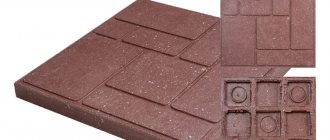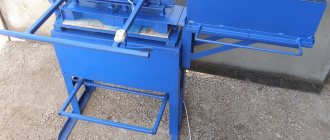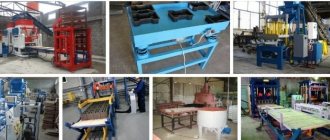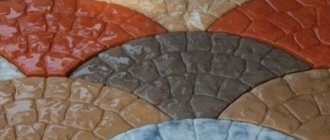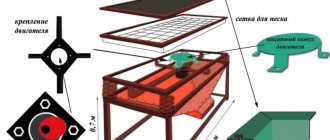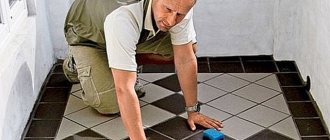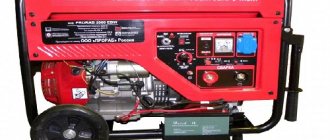The technology for making a homemade vibrating table for paving slabs will be useful for those who are planning to pave paths in the courtyard of an individual house. And also for private entrepreneurs who are ready to organize mini-production of tiles and paving stones for sidewalks and paths.
Paving slabs are a popular material among both public utilities and private homeowners. Easy to install, abrasion resistant, easy to maintain and other advantages of the tile have led to an increase in its popularity.
Many people, deciding to lay tiles on a large area, start making them themselves.
DIY vibration table for paving slabs
The main device that you need to buy to start the tile making process is a vibrating table. It is designed to compact the composition of the tile mold and remove air bubbles from it.
However, craftsmen also act independently here, preferring to make a vibration table with their own hands rather than buy a ready-made one. Moreover, you can make it from improvised means at home.
We will try to consider in detail how to make a vibration table with your own hands, in the form of step-by-step instructions.
Do-it-yourself vibropress
Over the past few years, the use of building blocks made from various mixtures of concrete with lightweight aggregates has become very popular. Wall material has always been expensive, and today you have to count every penny even more so. That is why developers are in no hurry to line up for ready-made cinder blocks, paving slabs and other materials that are made using relatively simple methods. Everyone is trying to save money, and as a result, a whole movement of people who like to pour concrete blocks on their own has appeared.
- Vibropress for blocks
- What types of brick presses are there?
- Vibropress for tiles
- Vibropress for cinder block
Workflow Stages
The most important thing that experts recommend starting the work process with is making detailed drawings of the future press.
Homemade vibropress for paving slabs
Now, according to the drawings, it is necessary to gradually manufacture each part of the future machine:
- Legs. To work, you need to purchase a number 10 channel and a pipe from 80 to 100 mm in diameter. Using a grinder, 4 pieces of the required length are cut. We must not forget about trimming all the edges of the workpieces. When making a stationary machine, an allowance of 26 mm must be made to the length of the legs. This is necessary in order to be able to bury the legs of the brick making machine into the base. If the equipment is of a portable type, then parking plates must be welded to the lower edges of the legs. This will make the machine more stable. For their manufacture, steel 3 mm thick is used.
- Frame. The upper part of the frame is made of channel and I-beam. All parts of the frame are cut out using a grinder and placed on a flat, horizontal surface. This is necessary in order to be able to quickly weld all parts of the workpieces together. After completing the welding work, all seams are thoroughly cleaned and coated with a special paint that has anti-corrosion properties.
- Tabletop. This part must be stable and durable. For this purpose, transverse struts are used. The tabletop frame and spacers are made using angle-type steel. Recommended material size 70 mm. The shape and dimensions of the tabletop frame should be similar to the same frame parameters. If there is a difference in the above parameters, it should not exceed 7 cm. After cutting the workpieces with a grinder and cleaning the edges of their cuts, they are laid out on a flat plane. After welding all the workpieces and cleaning the welding seams, a rectangular workpiece is cut to the size of the frame. For this purpose, sheet steel 8 - 10 mm thick is used. The rectangle is placed on the top of the frame and welded to it.
The use of steel as a working material ensures the strength and stability of the concrete block press during operation. This is a necessary condition, since during operation the equipment experiences quite strong vibration.
How to make a tabletop
The tabletop, which takes on a significant part of the workload, must be manufactured with an emphasis on rigidity and structural strength. Based on this, the frame of this element must be made not only from perimeter parts. The frame will also require cross braces. The format of the frame of the table top, made of angle steel seventy by seventy millimeters, must completely coincide with the format of the frame. In this case, the dimensions of the entire tabletop should exceed the dimensions of the frame by no more than seven centimeters.
The workpiece elements must be laid out horizontally, after which they are fastened by welding. Here, too, you will have to grind and clean all the welding seams. Next, you need to cut a rectangle from eight to ten millimeters thick sheet steel that matches the dimensions of the frame. This rectangle needs to be placed on the frame and welded on the bottom.
The principle of operation of a vibrating table for tiles
The easiest way is to cast tiles into ready-made molds. However, the resulting material is loose and inferior in strength even to ordinary concrete. In addition, due to its compact size, it is difficult to achieve uniform shrinkage of the mixture.
As a result, strong bonds are not formed between the constituent components, and air voids remain in the body of the tile. In addition to the banal loss of strength, water penetrates into cracks and cavities. At sub-zero temperatures, the resulting ice will break the stacked blocks.
To obtain denser and higher-quality artificial stone, equipment for the production of paving slabs is equipped with a vibrator. Industrial designs work precisely on this principle.
A tile vibration press produces durable stone with a smooth front surface that does not allow moisture to pass through.
The mixture is loaded into the mold, then it is compacted by pressure and vibration, after which the stone dries under certain conditions. The more powerful the pressure is applied to the material, the better the quality of the final product.
Moreover, the best density is obtained when using vibration compaction, that is, simultaneous exposure to pressure and vibration.
Such a machine costs a lot of money; for the production of blocks at home it is an unaffordable luxury (unless, of course, you are engaged in commerce). Therefore, for one-time work, it makes sense to make a brick press with your own hands.
There are two concepts, each with advantages and disadvantages. Moreover, any machine can be manufactured at minimal cost.
Complex machine (vibrator and press)
The vibration pressing device consists of two independent parts. The table with the matrices installed is attached to the frame using spring dampers. A rubber suspension can be used if sufficient vibration amplitude is provided. To dampen transverse vibrations, it is advisable to install a guide.
It is better to make the working surface massive so that there is no resonant buildup. A vibrator is rigidly attached to it. The principle of operation is the same as in the tamping installation (see part 1 of the article).
This design works well on a massive tile making machine. A hydraulic installation or a regular jack is used as a press. Depending on the components you can find, you can make a press driven by an electric motor.
The movable carriage moves along vertical guides using a chain mechanism. The structure is driven by a reduction gearbox, which can be organized using different gear ratios of the chain sprockets.
The press pusher has damper spring inserts that regulate pressure and protect the chain transmission from excessive loads. Limit switches are installed on the vertical guides. When the pusher lowers to the working position, the engine turns off.
The workpiece is compacted using vibration of the work table. The pressure is regulated by moving the limit switches, which allows you to experimentally select the force for various mixtures.
After lifting the pusher, the workpieces hold their shape well. They can be carefully removed from the matrix without waiting for the mixture to harden. This technology makes it possible to organize a continuous process for the production of paving slabs using vibrocompression.
An example of how a homemade brick making machine works - video
To make such a brick press with your own hands, you do not need expensive materials (despite the bulky design) . Metal profiles and angles can be purchased inexpensively at scrap metal collection points.
The motors are suitable from any old industrial electrical installation: decommissioned machines or ventilation systems. Springs can be taken from car dismantling sites, or from decommissioned agricultural machinery.
After selecting the components, a drawing is drawn up (it cannot be standard, since the work plan depends on your needs for the tiles and the availability of parts). Assembly is carried out by welding.
Bolted connections can become weak from constant vibration, and you will be forced to regularly tighten all fasteners. If the installation turns out to be large enough (depending on the power of the motors found), you will also receive a brick press for the production of the so-called French stone.
It is enough to just slightly modify the matrix and reduce the pusher pressure.
Which motor is better for a homemade vibrating table?
Users advise using a vibration motor for private production of paving slabs:
- IV-99 E (RUB 7,650): power 0.5 kW, power source – 220 V, weight 14.5 kg, driving force up to 5 kN, vibration frequency 3000 rpm.
- IV-98 E (8540 rubles): power 0.9 kW, power source - 220 V, weight 22.5 kg, driving force up to 11 kN, vibration frequency 3000 rpm. This vibration motor is distinguished by the presence of unbalances mounted on the rotor. Rotating with the rotor shaft, they create a driving force.
For production on an industrial scale, the IV-104 B vibrator is suitable: power 0.53 kW, power source - 380 V, weight 25 kg, driving force up to 6.3 kN, vibration frequency 1500 rpm.
The easiest and most economical way is to use an old engine from a washing machine, pumping station, etc., which will cost much less, within 1 thousand rubles. + turner (shaft (axis), eccentric, bearing race).
Homemade vibrating table for paving slabs - video
Construction of brick making machines for the production of paving slabs
To manufacture a brick press for the production of paving slabs (the price of the finished device is several times lower than its factory counterparts), it is enough to have high-quality metal, drawings with instructions, a welding machine, an electric motor with an eccentric, and hydraulic drive elements, if it is intended to be installed.
The basis of the design, which is subject to independent production, is:
- forming unit with or without hydraulic drive;
- vibrator;
- equipment
After assembly is completed, the equipment is tested, vibration parameters are calibrated, and the master must make sure that all rigid elements are stable. Before starting production, it is necessary to ensure that the work table is absolutely horizontal.
Engine selection
A vibration motor or factory-made electric motor is fixed on the tabletop, which allows you to create the necessary vibration.
No less popular is the use of a kinematic scheme, in which the engine is fixed to the frame.
In this case, it is assumed that a V-belt drive will be used.
The most popular and convenient option, from an operational point of view, is to equip a vibrating table for the production of paving slabs with an electric motor and then attach the eccentric to the shaft. A special imbalance must be fixed to the clamp, which is located on the shaft.
It is very convenient to use a fairly heavy and massive bolt as an imbalance, with the help of which the vibration force is regulated in the process of screwing on a certain number of nuts.
If you are interested in the technological process of making paving slabs, read the article.
An overview of plastic tile options and their costs is presented here.
Cinder block manufacturing technology
- The cinder block production process begins with the production of a concrete mixture. To prepare the solution , you will need water, slag and cement. Mixing is carried out using a mixer or concrete mixer.
You can perform the operation manually, but it is very labor-intensive and not everyone can do it. The only external condition is positive ambient temperature (since the mixture component includes water).
After preparing the solution, it must be poured into molds . They can be either without void formers or with them. The usual dimensions of the molds are 390x190x188.
This is followed by a compaction phase of the mixture . This operation is performed using a press and vibration. Vibropressing usually lasts no more than half a minute, in extreme cases (when using the simplest designs of vibropresses) – up to one and a half minutes. When the mold has already been sufficiently compacted, it is removed and left on a special pallet or, in extreme cases, on the floor.
Hardening of the cinder block. In order to obtain a ready-to-use product, no special conditions are required. The natural ambient temperature (preferably not lower than 20 degrees) will allow the cinder block to acquire the properties and characteristics at which the material is used in construction.
Hardening of cinder blocks is usually limited to 100 hours, but, in fact, it depends on the consistency of the material itself and can vary. Adding substances such as fulleron or relaxol will significantly reduce the hardening time. In order for the cinder block not to dry out, maximum air humidity is necessary.
Storage of finished material. After the completion of the technological process, the cinder blocks are sent to a warehouse, where they finally gain strength.
The video will tell you how cinder blocks are made on a special machine for their production:
